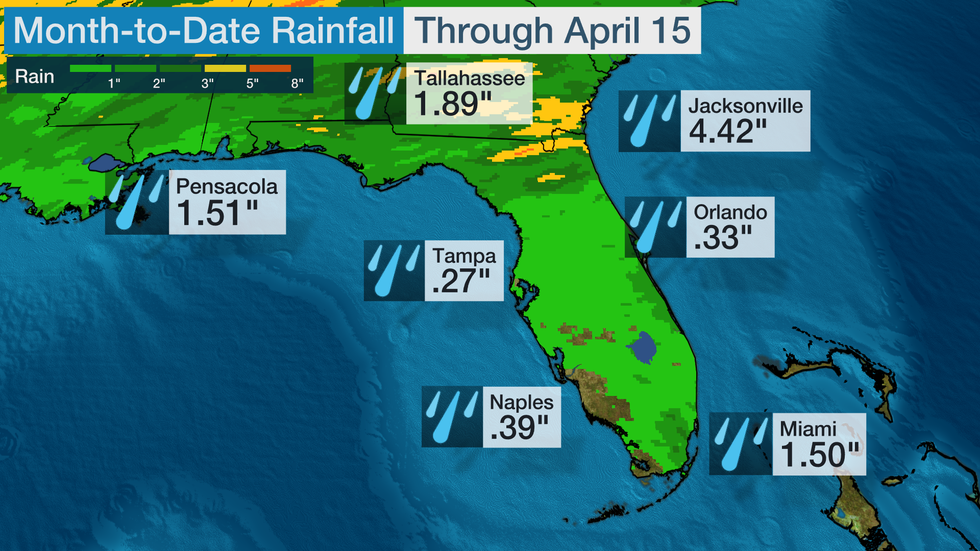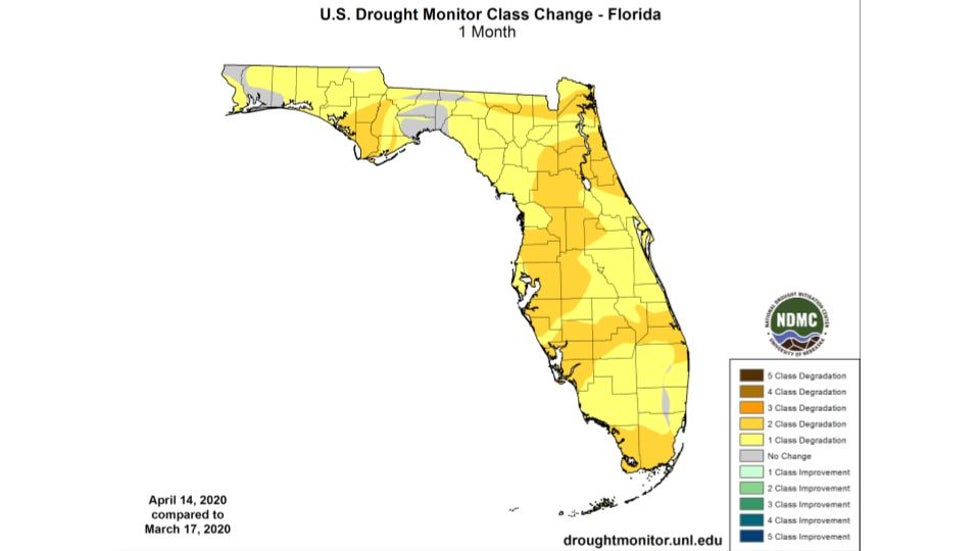Jonathan Belles
Published: April 16, 2020
The spring heat has continued into April across Florida, causing drought to worsen ahead of the typical dry season across nearly the whole sunshine state.
If you're not at least a part-time Florida resident, you may not know the state has a dry season. From late October through early May, Florida typically doesn't receive the type of daily downpours that have soaked many a summer afternoon at the beach or theme parks.
The period between April and the beginning of the rainy season, which typically begins by late May to mid-June, is the most dangerous time of the year for wildfires.
March saw very little rainfall in central and southern Florida, and the first two weeks of April have continued that pattern. Less than an inch has fallen in most spots on the peninsula through April 15.
 April Rainfall Through April 15
April Rainfall Through April 15
As of April 14, much of central and northeast Florida have dipped into severe drought.
For Florida, severe drought means that there can be large increases of wildfire abundance, browning and dying grasses and low hay yields, low lake and river levels with increasing salinity, and changing habits by mammals and reptiles, among other effects.
The U.S. Drought Monitor says that "short-term dryness has plagued the Gulf coast areas and Florida; over the last 90 days, this area is running precipitation deficits of 4-8 inches below normal....Without rain, further degradation is anticipated in the coming weeks."
This spring, high pressure has been persistent and strong near the Gulf Coast and Florida, steering frontal systems generally north of the Sunshine State.
Only one strong cold front made it into northern Florida, but this drought monitor does not include any rainfall after Tuesday, which means the 2-5 inches of rain that fell in northern Florida was not counted here. This rain will be counted in next week's drought update.
 Florida drought status in mid-April
Florida drought status in mid-April
The report on April 14 shows a one- to two-category worsening of the drought Florida since mid-March.
Even with some batches of rain in Florida's panhandle, their drought has worsened just as much as the rest of the state's.
In the last week, the most severe drying has taken place from Tampa Bay northeastward into the St. John's River basin.
 Change in drought status since mid-March. Yellow and orange colors indicate where drought has worsened.
Change in drought status since mid-March. Yellow and orange colors indicate where drought has worsened.
These changes are due to both record heat and a very dry period from March into April.
The U.S. Drought Monitor specially noted that Florida suffered from the country's greatest above-average temperature departures nationally, which were 6-8 degrees above normal for the week.
As weather.com meteorologist Brian Donegan has noted, Miami has been the epicenter of heat so far this month. Low temperatures have been as high as 80 degrees already so far, which is more typical of July or August. Miami has hit several other record high and record low temperatures this month.
And it isn't just Miami.
The first half of April has the warmest start to April on record in most cities south of Interstate-4, according to the Southeast Regional Climate Center.
 Temperature rankings for early April. 1's indicate where it has been the warmest early April on record.
Temperature rankings for early April. 1's indicate where it has been the warmest early April on record.
These all just continued a trend that began in March.
Daytona Beach, Fort Myers, Orlando, Pensacola and Sarasota each sweltered through their hottest March on record, according to the Southeast Regional Climate Center.
Jacksonville crushed its March all-time record high on March 28 by soaring to 94 degrees, tied or set nine daily record highs, most of any month, and had their most muggy March.
Fort Myers' nine days of 90-degree-plus heat more than doubled its previous March record from 1949.
If the current heat and humidity continue straight through the typical dry season, wildfires could become more likely.
The National Interagency Fire Center currently expects above-average fire activity in May across southern Florida.
The state's wet season, when heat and humidity build and ignite more frequent soaking thunderstorms, usually kicks into gear later in May or June.
The Weather Company’s primary journalistic mission is to report on breaking weather news, the environment and the importance of science to our lives. This story does not necessarily represent the position of our parent company, IBM.
The Weather Company’s primary journalistic mission is to report on breaking weather news, the environment and the importance of science to our lives. This story does not necessarily represent the position of our parent company, IBM.

No comments:
Post a Comment